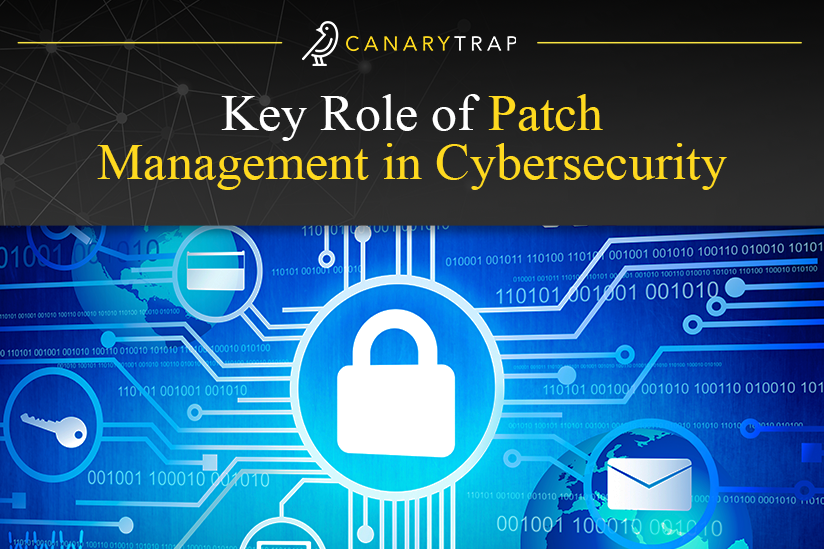Key Role of Patch Management in Cybersecurity
- June 9, 2023
- Canary Trap
Patch Management is a critical aspect of maintaining cybersecurity and overall system health. It involves acquiring, testing, and installing multiple patches (code changes) on existing applications and software tools to improve system performance or address security vulnerabilities.
The term ‘patch’ refers to a piece of software designed to update a computer program or its supporting data, primarily to fix or improve it. This could include fixing security vulnerabilities and other bugs and improving the usability or performance. Patches may be installed either automatically or manually.
In the context of cybersecurity, unpatched software provides an easy entry point for cybercriminals to exploit and gain unauthorized access to sensitive data. Therefore, effective patch management is essential to protect digital assets, ensure business continuity, and maintain customer trust.
The Importance of Patch Management in Cybersecurity
In our increasingly interconnected digital landscape, patch management plays a pivotal role in cybersecurity. Cyber threats are evolving at an unprecedented pace, with new vulnerabilities emerging regularly. Hackers and cybercriminals are always on the lookout for these vulnerabilities to exploit, often resulting in data breaches, system downtime, and reputational damage. Patch management acts as a crucial line of defense in this context, addressing these vulnerabilities by providing ‘patches’ or fixes to secure the system.
David Essex, industry editor at TechTarget explains that “Microsoft often provides patches to its Windows operating systems and other products such as Office. […] Many IT departments also maintain systems that run the open source Linux operating system, […] which is similar to Windows patching.” On the other hand, “MacOS also has built-in software update tools, but an organization can have multiple versions of the operating system, which makes it challenging to keep every system up to date without using centralized patch management.”
Regularly updated systems are less likely to fall prey to these cyber threats. Furthermore, patch management helps in maintaining the integrity and performance of IT systems, ensuring they are equipped with the latest features and safeguards. Without a robust patch management strategy, organizations run the risk of leaving their systems open to exploitation. It’s not just about protection, it’s also about staying ahead in the fast-paced world of technology where up-to-date systems often mean better functionality and competitive advantage.
Understanding Vulnerabilities: Why Regular Patching Is Essential
Vulnerabilities are flaws or weaknesses in a system that can be exploited to gain unauthorized access or cause damage. They can exist in operating systems, software applications, and even hardware. Vulnerabilities may arise from a variety of sources such as coding errors, design flaws, or lack of security controls.
When a vulnerability is discovered, developers typically release a patch to fix the issue. However, the window of time between the discovery of a vulnerability and the release and installation of a patch can be a dangerous period. This is known as a zero-day vulnerability, where cybercriminals can exploit the flaw before a patch is implemented.
One notable example of a zero-day attack was when government institutions in Europe were targeted by cybercriminals who exploited vulnerabilities in Microsoft Windows. As detailed in an article by Kaspersky, this zero-day exploit “abused a local privilege vulnerability in Microsoft Windows to run arbitrary code, install applications, and view and change the data on compromised applications. Once the attack was identified and reported to the Microsoft Security Response Center, a patch was developed and rolled out.”
Regular patching is essential to minimize this window of risk. Timely patch management not only rectifies known vulnerabilities but also proactively prevents potential security breaches. As new vulnerabilities are constantly being discovered, regular patching is the only way to keep your systems secure and up to date, reducing the likelihood of becoming a target for cybercriminals.
Patch Management Life Cycle: Steps and Key Considerations
The patch management lifecycle is a continuous process that involves several key steps. First, it begins with the identification of systems in the network. A comprehensive inventory of all hardware and software ensures no device goes unnoticed and vulnerable. Next, potential vulnerabilities are assessed and patches are acquired from trusted sources. It is critical to source patches from the official vendors to avoid counterfeit or harmful patches.
Once patches are acquired, they are tested in a controlled environment to verify their performance and compatibility with existing systems. Testing helps avoid potential conflicts or disruptions that could occur post-deployment. After thorough testing, the patches are deployed across the network. This phase may require scheduling and coordination to minimize disruption to business operations.
Post-deployment, it is necessary to verify the successful installation of patches and monitor for any issues. If any problems arise, they are addressed promptly to ensure system stability. Lastly, documentation of the entire process is crucial for audit trails and future reference.
The patch management lifecycle isn’t a “set it and forget it” process. It requires continuous monitoring and management. Key considerations include understanding the criticality of each patch, knowing which patches to prioritize based on potential risk, and being aware of the overall impact on the business. An effective patch management strategy must be proactive, comprehensive, and agile to adapt to the fast-evolving cyber threat landscape.
The Role of Patch Management In Compliance
Compliance with industry regulations and standards is a key driving factor for patch management. Many industries have strict requirements for maintaining up-to-date systems to ensure data privacy and security. For instance, the General Data Protection Regulation (GDPR) in the European Union requires organizations to implement appropriate technical and organizational measures to ensure a level of security appropriate to the risk, which includes regular testing, assessing, and evaluating the effectiveness of technical measures for ensuring data security.
Similarly, in the healthcare sector, the Health Insurance Portability and Accountability Act (HIPAA) demands that entities implement procedures for guarding against, detecting, and reporting malicious software and update procedures to protect against known security threats. Patch management, therefore, plays a vital role in ensuring organizations meet these security requirements and avoid hefty fines for non-compliance.
Moreover, compliance goes beyond meeting regulatory standards. It also involves adhering to the security best practices that are recommended in frameworks such as ISO 27001 or the NIST cybersecurity framework. By keeping systems updated and vulnerabilities patched, organizations can demonstrate their commitment to maintaining a secure environment for their data and that of their customers.
Best Practices for Effective Patch Management
For an effective patch management strategy, several best practices can be followed.
- First, establish a clear patch management policy that defines roles, responsibilities, processes, and timelines. This policy should be communicated across the organization and be adhered to consistently.
- Second, maintain an accurate inventory of all IT assets. Understanding what hardware and software are in your environment is crucial to identifying what needs to be patched. This should include all servers, workstations, laptops, mobile devices, and IoT devices.
- Third, prioritize patches based on risk. Not all patches need to be applied immediately. Those that address high-risk vulnerabilities, especially in critical systems, should be prioritized.
- Fourth, test patches before deployment. Deploying patches without testing them can lead to system instability or incompatibilities. It is highly recommended to test patches in a controlled environment before rolling them out widely.
- Fifth, automate where possible. Automation can greatly improve the efficiency and accuracy of patch management, particularly in large environments.
- Finally, regularly review and update your patch management process. As your IT environment evolves, so should your patch management strategy. Regular audits can help identify areas for improvement and ensure the process continues to effectively mitigate risks.
By adhering to these best practices, you can make your patch management process more efficient, effective, and capable of protecting your organization against evolving cybersecurity threats.
As experts at Intel aptly conclude: “Patch management is more benefit than burden. Having greater access and control over your devices, with the ability to patch and repair remotely, ultimately lends flexibility to your IT department and your business. While a lot of hazards are out there in the form of hackers and data thieves, patch management can help keep your business running smoothly. […] Whether it’s an employee laptop or userless PC-based device, such as a kiosk or digital signage, all systems need to be secured. The risks of ignoring patch management can include exposing your business to leaks and breaches, loss of productivity, and loss of reputation.”
In Conclusion
Patch management is an essential part of any organization’s cybersecurity strategy. Despite the challenges it presents, effective patch management is instrumental in protecting systems against vulnerabilities and mitigating the risk of cyber attacks. Understanding the nuances of patch management, including the life cycle, regulatory compliance requirements, and best practices that must be implemented for an effective patch management strategy will help organizations to upgrade their security measures against cyber threats.
Some of these best practices include: establishing and adhering to a clear patch management policy, maintaining accurate inventory of all IT assets, prioritizing patches based on risk, implementing automations, and constantly reviewing and updating your patch management process and strategy with security audits.
Remember, patch management is not a one-time task, but an ongoing process that requires consistent attention and dedication. The threats may be persistent, but with a well-planned, well-executed patch management strategy, you can keep your systems secure and stay one step ahead of the cybercriminals.
SOURCES:
- https://www.techtarget.com/searchenterprisedesktop/definition/patch-management
- https://www.kaspersky.com/resource-center/definitions/zero-day-exploit
- https://www.intel.com/content/www/us/en/business/enterprise-computers/resources/patch-management.html#:~:text=Effective%20patch%20management%20helps%20safeguard,unauthorized%20access%2C%20without%20sacrificing%20productivity.&text=Patch%20management%20helps%20IT%20teams,respond%20fast%20to%20known%20exploits.

